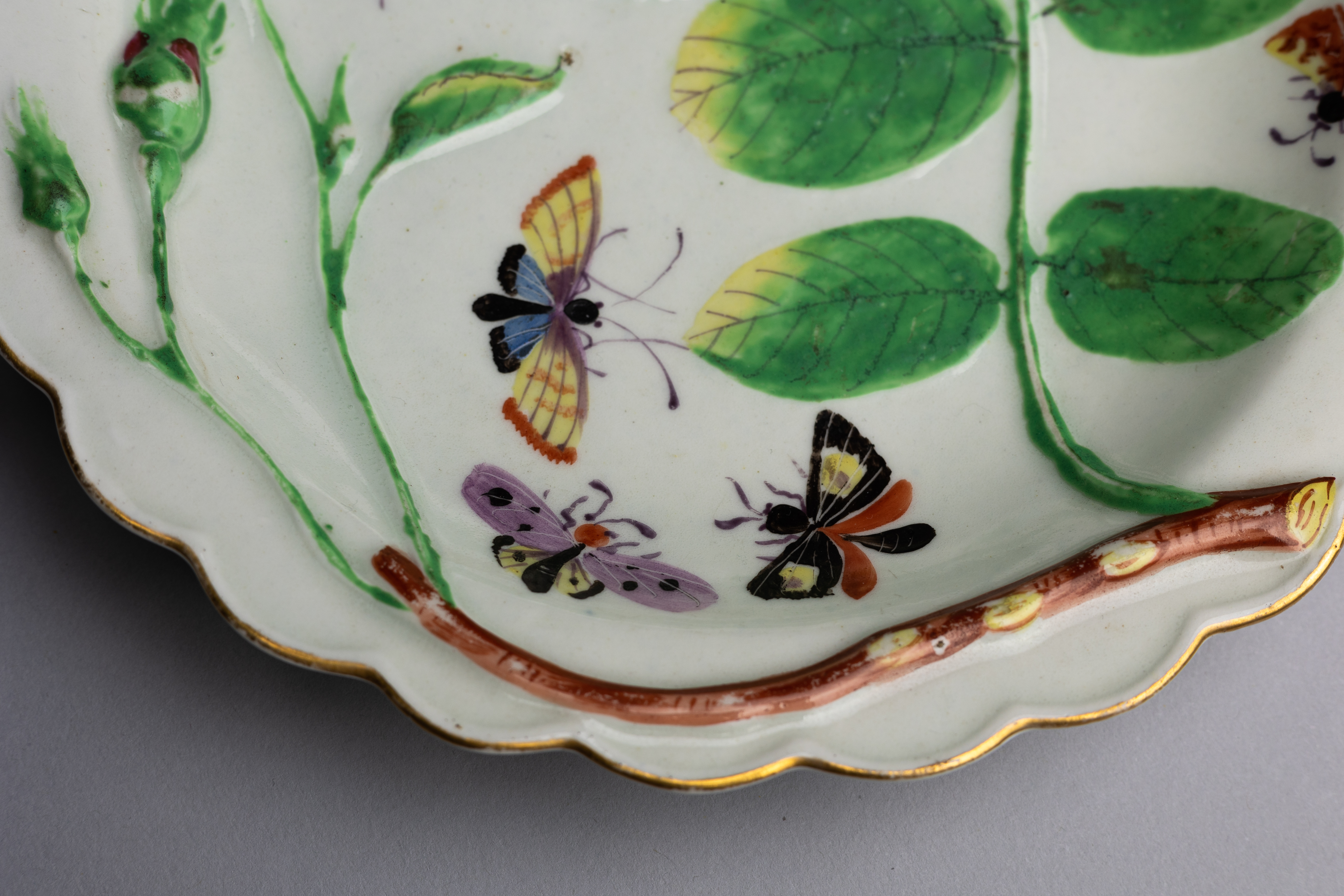With raised rosebuds, leaves, and branches among exquisitely hand-painted insects, this Blind Earl porcelain dish is a visual and tactile work of art. Popular accounts describe Worcester’s ‘Blind Earl pattern’ as being created out of an English aristocrat’s hunting accident. Despite a spurious origin story, this plate provides an important historical example of tactile, accessible design.
With raised rosebuds, leaves, and branches among exquisitely hand-painted insects, this Blind Earl porcelain dish is a visual and tactile work of art. Popular accounts describe Worcester’s ‘Blind Earl pattern’ as being created out of an English aristocrat’s hunting accident. Despite a spurious origin story, this plate provides an important historical example of tactile, accessible design.
Essay
In 1780, George William Coventry, the fifth Earl of Coventry, lost his eyesight in a hunting accident. The Earl commissioned the Worcester Porcelain Manufactory to produce a set of fine china with finely articulated raised decorations so that he might still experience the pieces through touch. Out of such a tragedy, beauty was born as the ‘Blind Earl’ porcelain pattern.
This tale is, however, closer to fantasy than fact. Readers will notice that this dish dates 10 years prior to the Earl’s famous accident; indeed, examples of this Worcester pattern can be found as early as the 1750s. Historians suspect that Coventry experienced hereditary blindness and the hunting accident story was fabricated as a way to disguise this. Perhaps he commissioned the pattern earlier, or maybe he acquired a set as his vision deteriorated. In any case, the pattern became known as ‘Blind Earl’ and was produced into the 19th and 20th centuries.
This pattern is beautiful both tactually and visually. The exquisitely painted decoration, attributed to the James Giles workshop, cannot be ignored. The brilliant green leaves are accented with insects: butterflies, a ladybug, and an ant. The inclusion of the lady bug an ant is a feature rarely found in the Blind Earl pattern.
While most antiques and works of art scream, “Don’t touch me!”, tactile experience of this exquisite dish is a prerequisite for true appreciation.
Condition
Excellent. Some slight rubbing to green leaf enamels. A shallow chip to the footrim.
For a detailed condition report, please contact us.
References
Gardiner Museum, G91.7.43 and G89.1.1
Museum of Fine Arts Houston, 85.116.1-2
Provenance
Albert Amor Ltd., London
In 1780, George William Coventry, the fifth Earl of Coventry, lost his eyesight in a hunting accident. The Earl commissioned the Worcester Porcelain Manufactory to produce a set of fine china with finely articulated raised decorations so that he might still experience the pieces through touch. Out of such a tragedy, beauty was born as the ‘Blind Earl’ porcelain pattern.
This tale is, however, closer to fantasy than fact. Readers will notice that this dish dates 10 years prior to the Earl’s famous accident; indeed, examples of this Worcester pattern can be found as early as the 1750s. Historians suspect that Coventry experienced hereditary blindness and the hunting accident story was fabricated as a way to disguise this. Perhaps he commissioned the pattern earlier, or maybe he acquired a set as his vision deteriorated. In any case, the pattern became known as ‘Blind Earl’ and was produced into the 19th and 20th centuries.
This pattern is beautiful both tactually and visually. The exquisitely painted decoration, attributed to the James Giles workshop, cannot be ignored. The brilliant green leaves are accented with insects: butterflies, a ladybug, and an ant. The inclusion of the lady bug an ant is a feature rarely found in the Blind Earl pattern.
While most antiques and works of art scream, “Don’t touch me!”, tactile experience of this exquisite dish is a prerequisite for true appreciation.
Excellent. Some slight rubbing to green leaf enamels. A shallow chip to the footrim.
For a detailed condition report, please contact us.
Gardiner Museum, G91.7.43 and G89.1.1
Museum of Fine Arts Houston, 85.116.1-2
Albert Amor Ltd., London
This item ships free to the continental US, and globally for a flat-rate fee of $75.
All objects are packed with utmost care by our team of expert fine art shippers. All items are shipped with parcel insurance.
For more information on our shipping policies, please visit our FAQ Page.
An essay for this object is forthcoming. Sign up for our email list to be the first to know when this essay is published!
Thank you!
You have successfully joined our subscriber list.









